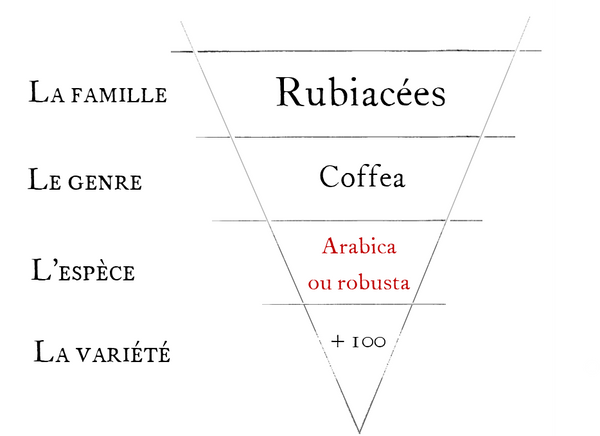Before differentiating between these two coffees , it is important to specify that there are 4 levels in coffee botany:
Hierarchy - nf
- Family : Coffee belongs to the plant family Rubiaceae, which includes for example bedstraw and dyer's madder.
- The genre: Within the Rubiaceae family, we find the genus Coffea, or coffee plant.
- The species: There are approximately 124 species of coffee, but two of them are primarily cultivated: Coffea arabica and Coffea canephora (which is often considered synonymous with Robusta because it is its most common variety). Two other species can be mentioned: Coffea liberica and Coffea excelsa, both edible, but whose presence is anecdotal.
- Variety: our two main species produce more than 100 different varieties. Like grape varieties in winemaking, these can be either natural mutations or crosses between two varieties, in order to adapt to environmental constraints (heat resistance and humidity), terroir characteristics (soil, altitude), and to address various challenges (productivity and disease resistance). Common varieties include Typica, Bourbon, Catuai, and Pacamara, which have themselves given rise to numerous sub-varieties, the details of which we will spare you here.

Differences - nf
If you were asked, you would probably answer that Arabica is much better and less strong than Robusta. But do you know why, and what are the specific characteristics of each of these varieties currently available on the coffee market?
Arabica
It originated in Ethiopia. This species only grows between 600m and 2400m altitude, with temperatures ranging from 15 to 24°C, which allows it to reach full maturity, developing its aromatic complexity and distinctive acidity. Arabica coffee is relatively susceptible to disease, depending on the variety.
The species represents 57% of the global market. Therefore, not all Arabica coffees are of equal quality. Superior quality depends on multiple factors such as the quality of the terroir, soil cultivation, coffee processing, altitude, and agroforestry to protect the plantations from the sun. The majority of production comes from Latin America and Central America, as well as East Africa.
Robusta
Its discovery came relatively late, in the 1870s in the Congo. It is significantly more resistant than Arabica to disease and high temperatures (22 to 30°C), and grows at low altitudes between 0 and 700 meters. Robusta is therefore easier to cultivate and, above all, less expensive. It represents 43% of the world market and is primarily used for instant coffee, blends, and some coffee capsules.
From an aromatic point of view, it is generally not very complex, but strong and bitter. Its caffeine content is twice as high as Arabica, which is largely responsible for the bitterness. Most Robusta is produced in Asia (Vietnam, Indonesia, and India), Brazil, and West Africa.
Celsius currently works exclusively with high-quality specialty Arabica coffees . This doesn't mean Robusta should be avoided. With the constraints of climate change, producing high-quality Arabica will become increasingly difficult, and it seems plausible that we will need to turn to alternative solutions, such as Robusta, in the coming decades. We are witnessing the emergence of specialty Robusta coffee, and we are confident that its quality will continue to improve over the years.


